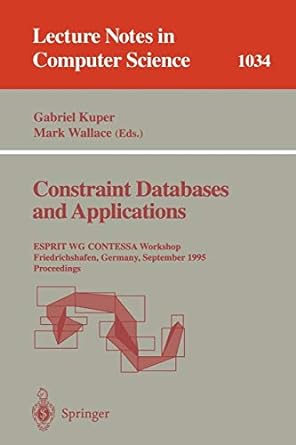Question
Write a report about the following topic: CS 388: Natural Language Processing Project Report Format Below are guidlines on how to write-up your report for
Write a report about the following topic:
CS 388: Natural Language Processing Project Report Format Below are guidlines on how to write-up your report for the final project. Of course, for a short class project, all of the comments may not be relevant. However, please use it as a general guide in structuring your final report.
A "standard" experimental NLP paper consists of the following sections:
1. Introduction
Motivate and abstractly describe the problem you are addressing and how you are addressing it. What is the problem? Why is it important? What is your basic approach? A short discussion of how it fits into related work in the area is also desirable. Summarize the basic results and conclusions that you will present.
2. Problem Definition and Algorithm
2.1 Task Definition
Precisely define the problem you are addressing (i.e. formally specify the inputs and outputs). Elaborate on why this is an interesting and important problem.
2.2 Algorithm Definition
Describe in reasonable detail the algorithm you are using to address this problem. A psuedocode description of the algorithm you are using is frequently useful. Trace through a concrete example, showing how your algorithm processes this example. The example should be complex enough to illustrate all of the important aspects of the problem but simple enough to be easily understood. If possible, an intuitively meaningful example is better than one with meaningless symbols.
3. Experimental Evaluation
3.1 Methodology
What are criteria you are using to evaluate your method? What specific hypotheses does your experiment test? Describe the experimental methodology that you used. What are the dependent and independent variables? What is the training/test data that was used, and why is it realistic or interesting? Exactly what performance data did you collect and how are you presenting and analyzing it? Comparisons to competing methods that address the same problem are particularly useful.
3.2 Results
Present the quantitative results of your experiments. Graphical data presentation such as graphs and histograms are frequently better than tables. What are the basic differences revealed in the data. Are they statistically significant?
3.3 Discussion
Is your hypothesis supported? What conclusions do the results support about the strengths and weaknesses of your method compared to other methods? How can the results be explained in terms of the underlying properties of the algorithm and/or the data.
4. Related Work
Answer the following questions for each piece of related work that addresses the same or a similar problem. What is their problem and method? How is your problem and method different? Why is your problem and method better?
5. Future Work
What are the major shortcomings of your current method? For each shortcoming, propose additions or enhancements that would help overcome it.
6. Conclusion Briefly summarize the important results and conclusions presented in the paper. What are the most important points illustrated by your work? How will your results improve future research and applications in the area?
Bilbiography Be sure to include a standard, well-formated, comprehensive bibliography with citations from the text referring to previously published papers in the scientific literature that you utilized or are related to your work.
Step by Step Solution
There are 3 Steps involved in it
Step: 1

Get Instant Access to Expert-Tailored Solutions
See step-by-step solutions with expert insights and AI powered tools for academic success
Step: 2

Step: 3

Ace Your Homework with AI
Get the answers you need in no time with our AI-driven, step-by-step assistance
Get Started


